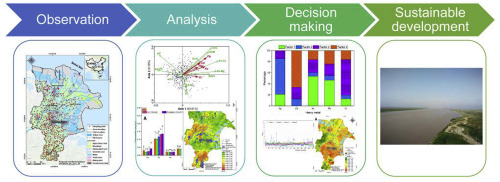Journal of Cleaner Production ( IF 9.7 ) Pub Date : 2019-02-15 , DOI: 10.1016/j.jclepro.2019.02.157 Yandong Gan , Xianmin Huang , Shuangshuang Li , Na Liu , Yuncong C. Li , Ariel Freidenreich , Wenxing Wang , Renqing Wang , Jiulan Dai

|
Accumulation of pollutants, especially heavy metals in river delta systems, pose a severe threat to the ecological environment and also hinder sustainable development of deltas. A total of 390 samples were collected from farmlands throughout the Yellow River Delta (YRD), the fastest growing delta in the world, to explore the holistic distribution characteristics and restrictive environmental factors of mercury (Hg), cadmium (Cd), arsenic (As), lead (Pb), and chromium (Cr) in the soil. Results indicated that soils in farmlands at the YRD had relatively low average concentrations of selected elements with non-contamination level. This is due to low elemental contents of loess parent materials and less human activities. These elements in soils had distinct spatial distributions and disparities from different categories, which were predominately determined by soil physicochemical properties such as cation exchange capacity, organic matter content, clay fraction and soil acidity. Sodium salt played a vital role in this delta for soil salinization. Agricultural inputs, industrial emissions, and river suspended sediments were the three primary sources of these elements. Of these elements, 65% of Hg came from atmospheric deposition, 66% of Cd was sourced from industrial emissions, 53% of As and 46% of Pb originated from agricultural inputs, and 64% of Cr was rooted from parent materials. Based on these findings, critical strategies including controlling the agrochemical input and removing industrial pollutant emission were proposed for sustainable development of the YRD.
中文翻译:

黄河三角洲农田土壤中汞,镉,砷,铅和铬的来源定量和潜在风险
污染物的积累,尤其是三角洲系统中的重金属,对生态环境构成了严重威胁,也阻碍了三角洲的可持续发展。从世界上增长最快的三角洲黄河三角洲(YRD)的农田中总共采集了390个样本,以探索汞(Hg),镉(Cd),砷(As ),土壤中的铅(Pb)和铬(Cr)。结果表明,长三角地区农田中的土壤中所选元素的平均浓度相对较低,且没有污染。这是由于黄土母体物质的元素含量较低,而人类活动较少。土壤中的这些元素具有不同类别的明显空间分布和差异,它们主要由土壤的理化性质决定,如阳离子交换能力,有机质含量,黏土分率和土壤酸度。钠盐在这个盐渍化土壤中起着至关重要的作用。农业投入,工业排放和河流悬浮沉积物是这些元素的三个主要来源。在这些元素中,汞的65%来自大气沉积,镉的66%来自工业排放,53%的砷和46%的铅来自农业投入物,而铬的64%来源于母体材料。基于这些发现,提出了包括控制农用化学品投入和消除工业污染物排放在内的关键战略,以促进长三角开发的可持续发展。粘土分数和土壤酸度。钠盐在这个盐渍化土壤中起着至关重要的作用。农业投入,工业排放和河流悬浮沉积物是这些元素的三个主要来源。在这些元素中,Hg的65%来自大气沉积,Cd的66%来自工业排放,53%的As和46%的Pb来自农业投入物,而64%的Cr源自母体材料。基于这些发现,提出了包括控制农用化学品投入和消除工业污染物排放在内的关键战略,以实现长三角开发的可持续发展。粘土分数和土壤酸度。钠盐在这个盐渍化土壤中起着至关重要的作用。农业投入,工业排放和河流悬浮沉积物是这些元素的三个主要来源。在这些元素中,汞的65%来自大气沉积,镉的66%来自工业排放,53%的砷和46%的铅来自农业投入物,而铬的64%来源于母体材料。基于这些发现,提出了包括控制农用化学品投入和消除工业污染物排放在内的关键战略,以促进长三角开发的可持续发展。在这些元素中,汞的65%来自大气沉积,镉的66%来自工业排放,53%的砷和46%的铅来自农业投入物,而铬的64%来源于母体材料。基于这些发现,提出了包括控制农用化学品投入和消除工业污染物排放在内的关键战略,以促进长三角开发的可持续发展。在这些元素中,汞的65%来自大气沉积,镉的66%来自工业排放,53%的砷和46%的铅来自农业投入物,而铬的64%来源于母体材料。基于这些发现,提出了包括控制农用化学品投入和消除工业污染物排放在内的关键战略,以促进长三角开发的可持续发展。


















































 京公网安备 11010802027423号
京公网安备 11010802027423号